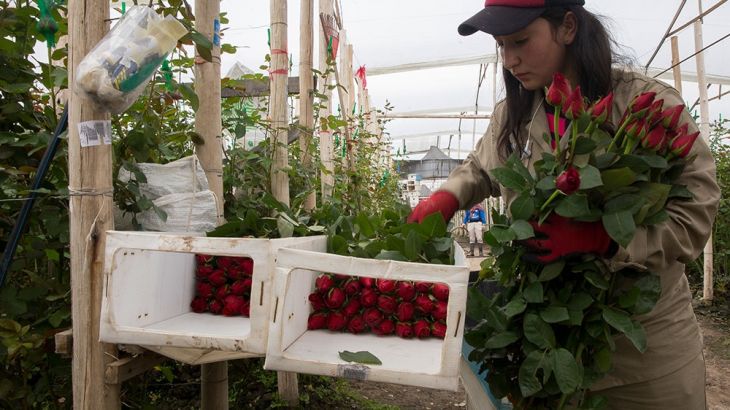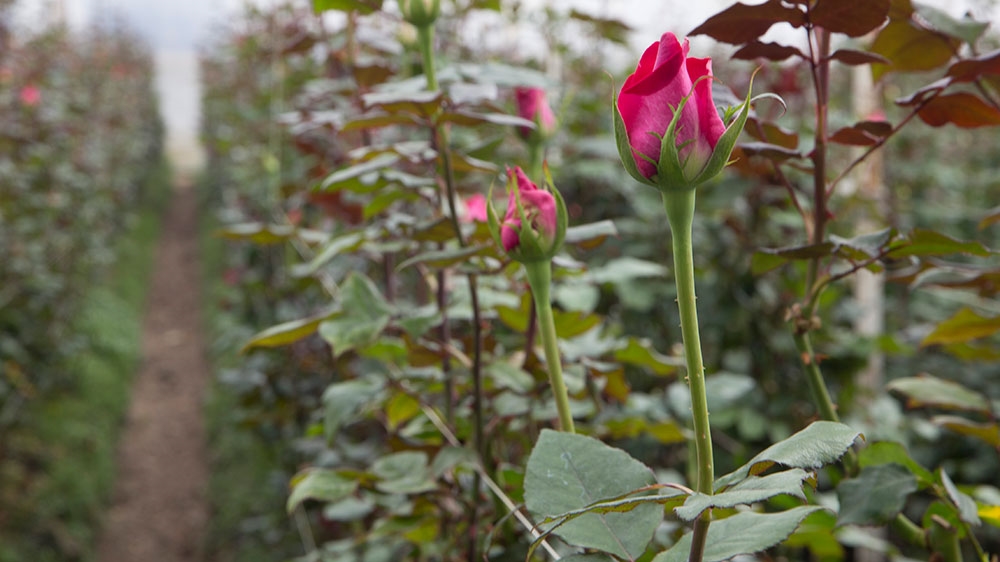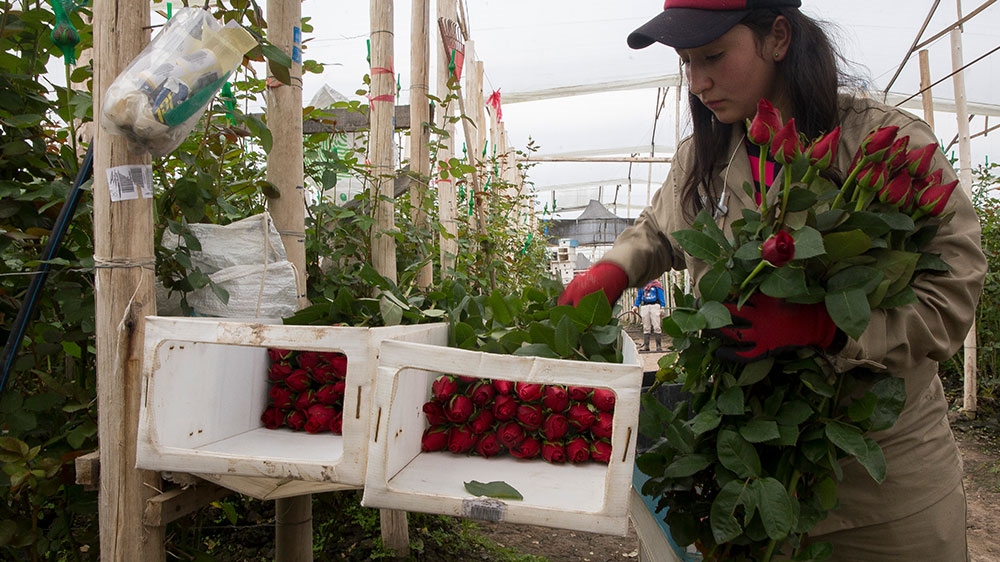From drugs to flowers: Colombia’s Valentine’s Day rose boom
Flowers were supposed to be substitution crops for coca. The flower industry is booming but so is coca production.

Suesca, Colombia – Rose farms in Colombia‘s high-reaching savannas were all action weeks before Valentine’s Day.
Farmers wound through long rows of rose bushes, clipping deep red flowers and adding them to a large stack of roses swaddled in their arms like babies.
Keep reading
list of 4 itemsBoeing hit with 32 whistleblower claims, as dead worker’s case reviewed
US imposes new sanctions on Iran after attack on Israel
A flash flood and a quiet sale highlight India’s Sikkim’s hydro problems
Men pushed carts brimming with boxes of red, pink, yellow and white blossoms out of giant greenhouses and into the hands of production teams.
Workers picked through the roses at a rapid pace, trimming, plucking, sorting and bundling each flower into luscious bouquets that in 48 hours would land in supermarkets across the United States.
For flower producers in the South American country, the holiday is less a day of love, and more a three-week sprint to the finish.

Colombia is the second-biggest exporter of flowers in the world, after the Netherlands. Cut flowers are one of the country’s biggest exports alongside coffee, petroleum, coal and precious materials.
This year, Colombia expects to export more than $1.5bn in flowers – about 660 million blossoms – according to data from Colombian Association of Flower Exporters (Asocolflores). The vast majority arrive in the US, Colombia’s biggest trade partner.
February 14, Valentine’s Day, is the most important day for Colombian flower growers like Fantasy Farms, a farm in the highlands near the country’s capital Bogota. The day alone makes up 20 percent of their annual sales, said Dora Chriva, director of operations at the farm.
“Right now, we say that we’re 24/7,” Chriva said, as flower farmers mill by. It is a crucial day for growers, though Colombian culture does not even celebrate the holiday.
“The Valentine’s Day celebration requires extra work,” Chriva said. “The volume of flowers that you have for this celebration occupies a bit more than your established schedule … We work really hard for nearly three weeks in production for the day of love.”
But flower trade only took off in the South American country in the 1990s, and the growth of the trade, while benefitting the economy and job market, did not have all of its intended effects.
A substitute for coca?
In the 1990s, Colombian drug cartels relied on the cultivation of the coca plant to fuel their cocaine empire and the Colombian government and US were looking for ways to curb drug production.
To offer incentives for alternative crops, the US under the administration of President George HW Bush passed the Andean Trade Preference Act in 1991, which dropped duties on agricultural products like flowers for Colombia, Ecuador, Peru and Bolivia.
“Colombia’s economy needed to diversify away from illicit economies, mostly centred around narco-trafficking,” said Sergio Guzman, director of Colombia Risk Analysis. “The idea from the United States and Colombian governments was to form a series of agricultural products that could diversify Colombia’s economy and drive it away from a coca-centred economy.”
In 2002, then-President George W Bush took it a step further, replacing the trade deal with the Andean Trade Promotion and Drug Eradication Act, which pushed countries like Colombia to cooperate with so-called “war on drugs” counter-narcotic efforts.
Colombia used an aggressive aerial fumigation programme, spraying those crops with glyphosate, a chemical thought to cause cancer. Between the early 1990s and 2015, when the fumigation practice was suspended, US pilots and Colombian police sprayed 4.4 million acres (17.8 million hectares) of Colombia with the chemical. While the effort nearly eradicated coca production, the method was deeply controversial.
At the same time, the government promoted legal alternatives like flowers and coffee.

Flower exports steadily grew after 1991. Between 2001 and 2020, flower exports from Colombia shot up from $630m annually to an estimated $1.5bn, Ascolflores data shows. Today, about 80 percent of the flowers lining US market shelves come from Colombia.
But even as the flower industry bloomed, roses and other crops could not fill the coca’s gap, analysts say.
“You have to understand the issue with the drug war and, in part, the cocaine production in Colombia is that the demand is very inflexible,” Guzman said. “There is an inelastic demand for drugs.”
Cocaine production continues to soar in Colombia, hitting a record high in 2017. After US President Donald Trump threatened to cut off Colombia from aid and “decertify” the country as a partner on its “war on drugs”, the Duque government announced it intended to resume aerial fumigation.
While coca was grown in remote regions, the flowers needed to be grown in towns like Suesca, where they could be transported in little more than an hour to export in Bogota’s international airport. Instead of becoming a substitute, Guzman said roses and carnations instead became an “alternative”, creating a new industry in the South American country, but failing to combat Colombia’s multi-billion dollar cocaine trade.
‘Begging us to export them’
Still, the country and its residents have benefitted from the flower market boom.
In the country with high unemployment and informal employment rates, the industry created 140,000 formal jobs for Colombians. On average, flower workers earn just a little over Colombia’s minimum wage, around $290 a month, however. Colombian President Ivan Duque said Tuesday that the country hopes to double flower exports to $3bn by 2030 by expanding to markets in Asia and Latin America.
Yenny Alexandra Velasquez, 23, was among throngs of rose farmers picking through stacks of red roses in one of Fantasy Farms’ 30 greenhouses.

The farm is tucked in savannas of her home of Suesca, Colombia. The town’s temperate climate offers the perfect conditions for the cultivations to flourish. Flower growing had been in the young Colombian farmer’s family for generations.
“Practically all of my family has dedicated ourselves to this,” Velasquez said, clipping flower stems as she spoke. “My mom, my dad, my grandma, my aunts and uncles. … Since I can remember, they’ve been cutting.”
But when Velasquez was a child, she remembered it was just a few small farms speckling the rolling hillsides. Today, those farms have been replaced by miles of greenhouses like those at Fantasy Farms.
While Colombia produces 1,600 different kinds of flowers, roses have become the bread-and-butter of exports.
Velasquez said the job offered her an opportunity to save money to attend university and provide for her three-year-old daughter.
“I haven’t had the chance to study,” she said. “So meanwhile I am working here to earn money to pay for my education.”

The growth of the flower market was clear as farmers geared up for Valentine’s Day this year.
Salsa music echoed through production chains as roses were vigorously packed and sent down a conveyer belt, and through the greenhouses where farmers like Velasquez examined blossoms with a trained eye.
“(You know the flower is perfect) from the tips, the tip should be just a little open,” she said, peering down at a bundle of flawless-looking flowers, the deep red petals still sealed together like an envelope. “Right now, they are begging us to export them.”